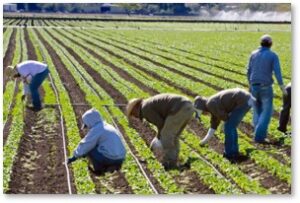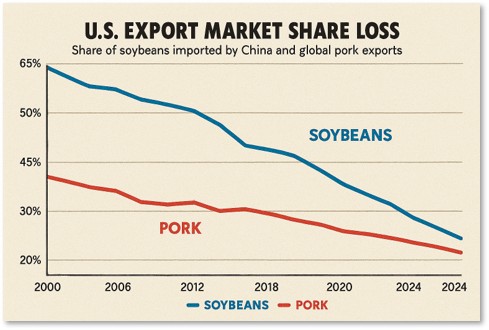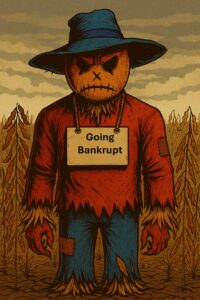“Fool me once, shame on you; fool me twice, shame on me”
The current president has fooled America’s farmers twice now and things are getting worse by the week. You might think our hardworking farmers would have learned from Number 47’s first administration, when he destroyed their markets for soybeans and pork. But no.
They bought the lies in 2024 and actively voted against their own best interests for a second time. Here’s what happened next and how it has affected farmers:
1. The Immigration Crackdown
 By voting for Trump’s promise to deport undocumented immigrants, farmers ensured that the people they need to run their farms would be deported.
By voting for Trump’s promise to deport undocumented immigrants, farmers ensured that the people they need to run their farms would be deported.
It did not seem to occur to them that they would be losing the men and women who make up the labor force they need to stay in business. They probably believed the lie that only criminals would be deported, when that was just a smokescreen.
The administration’s deportation policies and visa restrictions have created severe shortages of migrant labor, which is essential for harvesting crops and managing livestock. As crops rot in the fields, fruit falls from the trees, pigs don’t go to market, and cows go unmilked, farmers are finding out the hard way exactly how important that immigrant labor and those seasonal workers are for maintaining productivity and generating profits.
2. Market Share Loss
In his first administration, Trump destroyed the markets for soybeans and pork, especially in exports to China. Now, he’s doing it again. His tariffs and unbridled insults have dried up the whole markets leaving farmers holding onto to crops and animals with nowhere to sell them.
After Trump imposed steep tariffs on Chinese goods, China responded by halting purchases of major U.S. agricultural exports like soybeans, corn, pork, and poultry. China was the largest buyer of U.S. soybeans, consuming 61% of global production. Losing that market devastated farmers in states like Iowa, Illinois, and Indiana.
 Between 2018 and 2019 alone, retaliatory tariffs led to over $27 billion in lost agricultural exports. Countries like Brazil and Argentina have seized the opportunity to replace those U.S. exports, eroding America’s share in global agricultural markets.
Between 2018 and 2019 alone, retaliatory tariffs led to over $27 billion in lost agricultural exports. Countries like Brazil and Argentina have seized the opportunity to replace those U.S. exports, eroding America’s share in global agricultural markets.
Soybeans accounted for more than 70% of those losses. American farmers find themselves running up against global competition after they had already planted the fields. It left them with the sunk cost of planting with nowhere to sell the resulting crop.
3. Tariffs and the Trade War
Trump’s tariffs have also raised the price of virtually everything the American farmer needs to buy, from tractors to livestock feed, to fertilizer. Farm production expenses are projected to hit $467.4 billion in 2025, up $12 billion from last year.
At the same time, commodity prices have dropped: Soybean and corn futures have declined by over 40% since 2022, squeezing the farmers’ profit margins. With fewer export outlets due to the tariff war, surplus meat and grain have flooded domestic markets, driving prices down further.
4. Cancellation of Biden Administration Policies
Trump cancelled significant programs the Biden Administration put in place to help farmers grow, expand and prosper, as well as to promote conservation. Here’s what they were and why they mattered.
- The Climate-Smart Commodities Program. Trump canceled The USDA’s Partnerships for Climate-Smart Commodities (PCSC), a $3 billion initiative launched to help farmers adopt sustainable practices and access new markets.
PCSC funded projects that paid farmers to reduce emissions, improve soil health, and certify climate-friendly crops—opening doors to premium pricing and global demand. Current USDA Under Secretary Brooke Rollins called it a “green new scam,” citing high administrative costs and limited direct farmer benefit.
The result was that many farmers lost access to grants and technical support midstream. Projects were halted unless they could prove that 65% of funds went directly to producers. Initial investments were wasted as projects could not be completed.
- The 2023 Public Lands Rule, which allowed conservation leases on federal lands—putting restoration on equal footing with grazing, mining, and drilling. This rule gave ranchers and farmers a pathway to lease land for ecological stewardship, wildfire prevention, and sustainable grazing.
The administration argued the Public Lands Rule violated the “multiple-use” mandate and threatened traditional land uses. Ranchers who had begun planning for conservation leases got stuck in limbo. The reversal favors extractive industries and removes incentives for sustainable land management.
- A shift in USDA Grant priorities rebranded existing climate-smart grants under the “Advancing Markets for Producers” (AMP) initiative. New criteria dictate that at least 65% of funds must go directly to farmers. Grant recipients must also have enrolled and paid at least one farmer by the end of 2024.
While these new rules may sound reasonable, they disqualified many NGOs and university-led partnerships, leaving farmers without technical assistance or support for market access.
Net Effect on Farmers
 The net effect on farmers of these cancellations, layered atop trade war losses and labor shortages, has been to leave farmers navigating a volatile policy landscape with fewer tools to help them adapt. Many are seeing their farms pulled out from under them.
The net effect on farmers of these cancellations, layered atop trade war losses and labor shortages, has been to leave farmers navigating a volatile policy landscape with fewer tools to help them adapt. Many are seeing their farms pulled out from under them.
They owe money for programs started under President Biden but canceled midway by President Trump. They must come up with more money as the daily expenses of running a farm increase. Global competition has risen as countries like Brazil and Argentina have seized the opportunity to replace U.S. exports. Some markets have virtually disappeared.
- Soybeans: The U.S. lost over half its share of China’s soybean market between 2000 and 2024. Brazil now dominates, exporting over 2.4 billion bushels to China in 2025 alone.
- Pork: U.S. pork exports have declined steadily, with the EU and Brazil overtaking key Asian markets. China’s temporary bans and preference for cheaper suppliers accelerated the shift.
All this erodes America’s share in global agricultural markets. And those markets may never come back.
We Tried to Warn the Farmers
 Many experts tried to warn the farmers of the impact Trump’s policies would have on them. But they bought the lies and exaggerated threats about undocumented immigrants, trans athletes, inflation, and cultural issues.
Many experts tried to warn the farmers of the impact Trump’s policies would have on them. But they bought the lies and exaggerated threats about undocumented immigrants, trans athletes, inflation, and cultural issues.
Distracted by non-problems that would have no personal impact, farmers ignored or discounted the effect Republican policies would have on them directly.
America’s farmers have now been fooled twice. Have they learned? Or will they continue supporting a party that doesn’t support them?
